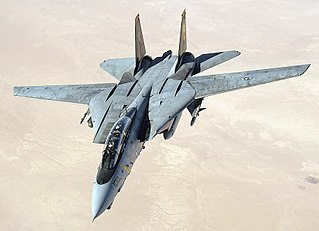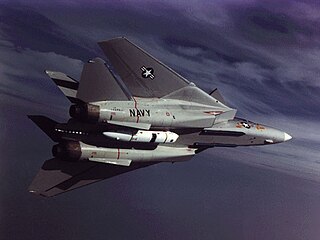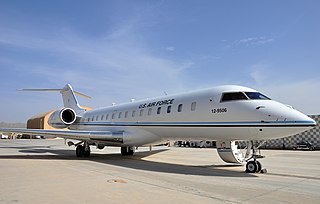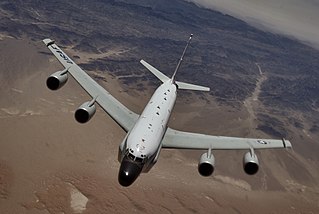
The Grumman F-14 Tomcat is an American carrier-capable supersonic, twin-engine, two-seat, twin-tail, all-weather-capable variable-sweep wing fighter aircraft. The Tomcat was developed for the United States Navy's Naval Fighter Experimental (VFX) program after the collapse of the General Dynamics-Grumman F-111B project. A large and well-equipped fighter, the F-14 was the first of the American Teen Series fighters, which were designed incorporating air combat experience against MiG fighters during the Vietnam War.

The McDonnell Douglas F/A-18 Hornet is an all-weather supersonic, twin-engine, carrier-capable, multirole combat aircraft, designed as both a fighter and attack aircraft. Designed by McDonnell Douglas and Northrop, the F/A-18 was derived from the latter's YF-17 in the 1970s for use by the United States Navy and Marine Corps. The Hornet is also used by the air forces of several other nations, and formerly by the U.S. Navy's Flight Demonstration Squadron, the Blue Angels.

The M230 Cannon is a 30 mm (30×113 mm), single-barrel electrically-driven autocannon, using external electrical power to cycle the weapon between shots. It was designed and manufactured originally by Hughes Helicopters in Culver City, California. As of 2019, it is produced by Northrop Grumman Innovation Systems.
A naval flight officer (NFO) is a commissioned officer in the United States Navy or United States Marine Corps who specializes in airborne weapons and sensor systems. NFOs are not pilots (naval aviators), but they may perform many "co-pilot" or "mission specialist" functions, depending on the type of aircraft. Until 1966, their duties were performed by both commissioned officer and senior enlisted naval aviation observers (NAO).

The Yakovlev Yak-25 was a swept wing, turbojet-powered interceptor and reconnaissance aircraft built by Yakovlev and used by the Soviet Union.

RAPTOR was a reconnaissance pod used by the Royal Air Force on its fleet of Tornado GR.4A and GR.4 aircraft. RAPTOR was manufactured by the Goodrich Corporation, initially part of UTC Aerospace Systems, but now part of Collins Aerospace.
The Digital Joint Reconnaissance Pod is a wide area tactical aerial reconnaissance pod produced by Thales Optronics of Bury St Edmunds, England. It is a later version of a pod produced for the UKMoD and the RAF Jaguar force, originally developed and produced by W. Vinten Ltd. The original designation of the pod was Jaguar Replacement Reconnaissance Pod (JRRP) and after successfully entering service in the 1990s it was subsequently redesignated DJRP, and fitted to a wide range of other aircraft.

The Tactical Airborne Reconnaissance Pod System (TARPS) was a large and sophisticated camera pod carried by the Grumman F-14 Tomcat. It contains three camera bays with different type cameras which are pointed down at passing terrain. It was originally designed to provide an interim aerial reconnaissance capability until a dedicated F/A-18 Hornet reconnaissance version could be fielded. TARPS was pressed into service upon arrival in the fleet in 1981, and remained in use up to the end of Tomcat service in 2006.

VMFA(AW)-332 Marine All Weather Fighter Attack Squadron 332 was a United States Marine Corps F/A-18 Hornet squadron. Also known as the "Moonlighters", the squadron was based at Marine Corps Air Station Beaufort, South Carolina as part of Marine Aircraft Group 31 (MAG-31), 2nd Marine Aircraft Wing. The squadron flew its last flight in the F/A-18 Hornet on 30 March 2007. At the time of their deactivation, they held the longest streak of mishap-free flight hours for a tactical jet squadron at 109,000 hours.

The Battlefield Airborne Communications Node (BACN) is a United States Air Force (USAF) airborne communications relay and gateway system carried by the unmanned EQ-4B and the manned Bombardier E-11A aircraft. BACN enables real-time information flow across the battlespace between similar and dissimilar tactical data link and voice systems through relay, bridging, and data translation in line-of-sight and beyond-line-of-sight situations. Its ability to translate between dissimilar communications systems allows them to interoperate without modification.

Training Squadron EIGHT SIX (VT-86), also known as the "Sabrehawks," is a United States Navy advanced jet training squadron based at the Naval Air Station Pensacola, Florida. Training Squadron 86 is a tenant command of Training Air Wing 6. They are a training squadron flying the T-45C Goshawk. Their tailcode is F and their radio callsign is ROKT.

Marine Tactical Reconnaissance Squadron 3 (VMFP-3) was an aviation unit of the United States Marine Corps active between 1975 and 1990.
List of abbreviations, acronyms and initials related to military subjects such as modern armour, artillery, infantry, and weapons, along with their definitions.

Signals intelligence operational platforms are employed by nations to collect signals intelligence, which is intelligence-gathering by interception of signals, whether between people or between machines, or mixtures of the two. As sensitive information is often encrypted, signals intelligence often involves the use of cryptanalysis. However, traffic analysis—the study of who is signalling whom and in what quantity—can often produce valuable information, even when the messages themselves cannot be decrypted.

A large number of variants of the General Dynamics F-16 Fighting Falcon have been produced by General Dynamics, Lockheed Martin, and various licensed manufacturers. The details of the F-16 variants, along with major modification programs and derivative designs significantly influenced by the F-16, are described below.
The reconnaissance mission within the United States Marine Corps is divided into two distinct but complementary aspects; Marine Division Recon and Force Reconnaissance.












